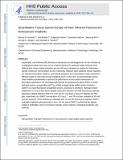Quantitative Tissue Spectroscopy of Near Infrared Fluorescent Nanosensor Implants
Author(s)
Iverson, Nicole M.; Bisker Raviv, Gili Hana; Farias, Edgardo; Ivanov, Vsevolod M; Ahn, Jiyoung; Wogan, Gerald N; Strano, Michael S.; ... Show more Show less
DownloadQuantitative tissue.pdf (1.114Mb)
OPEN_ACCESS_POLICY
Open Access Policy
Creative Commons Attribution-Noncommercial-Share Alike
Terms of use
Metadata
Show full item recordAbstract
Implantable, near infrared (nIR) fluorescent nanosensors are advantageous for in vivo monitoring of biological analytes since they can be rendered selective for particular target molecule while utilizing their unique optical properties and the nIR tissue transparency window for information transfer without an internal power source or telemetry. However, basic questions remain regarding the optimal encapsulation platform, geometrical properties, and concentration ranges required for
effective signal to noise ratio through biological tissue. In this work, we systematically explore these variables quantitatively to optimize the performance of such optical nanosensors for biomedical applications. We investigate both alginate and polyethylene glycol (PEG) as model
hydrogel systems, encapsulating d(GT)[subscript 15] ssDNA-wrapped single walled carbon nanotubes (SWNT) as model fluorescent nanoparticle sensors, responsive to riboflavin. Hydrogel sensors implanted 0.5 mm into thick tissue samples cause 50% reduction of initial fluorescence intensity,
allowing an optical detection limit of 5.4 mm and 5.1 mm depth in tissue for alginate and PEG gels, respectively, at a SWNT concentration of 10 mg L−1, and 785 nm laser excitation of 80 mW and 30 s exposure. These findings are supported with in vivo nIR fluorescent imaging of SWNT
hydrogels implanted subcutaneously in mice. For the case of SWNT, we find that the alginate system is preferable in terms of emission intensity, sensor response, rheological properties, and shelf life.
Date issued
2016-05Department
Massachusetts Institute of Technology. Department of Biological Engineering; Massachusetts Institute of Technology. Department of Chemical Engineering; Massachusetts Institute of Technology. Department of PhysicsJournal
Journal of Biomedical Nanotechnology
Publisher
American Scientific Publishers
Citation
Iverson, Nicole M., Gili Bisker, Edgardo Farias, Vsevolod Ivanov, Jiyoung Ahn, Gerald N. Wogan, and Michael S. Strano. “Quantitative Tissue Spectroscopy of Near Infrared Fluorescent Nanosensor Implants.” Journal of Biomedical Nanotechnology 12, no. 5 (May 1, 2016): 1035–1047.
Version: Author's final manuscript
ISSN
1550-7033